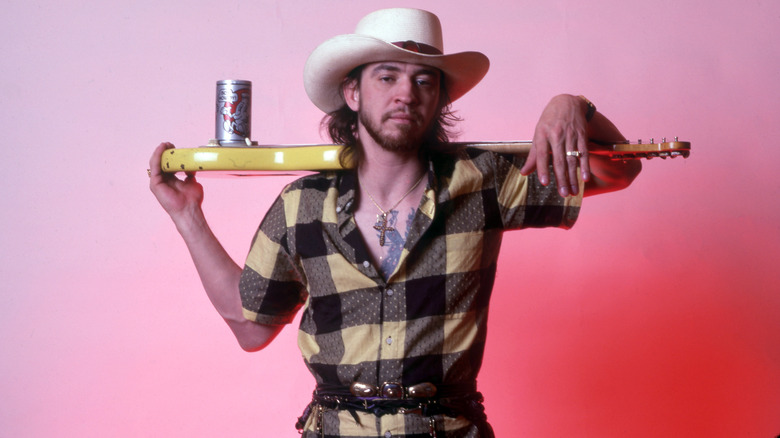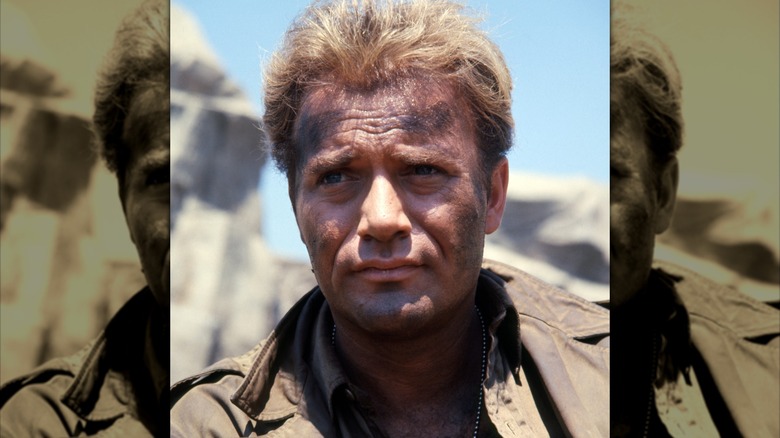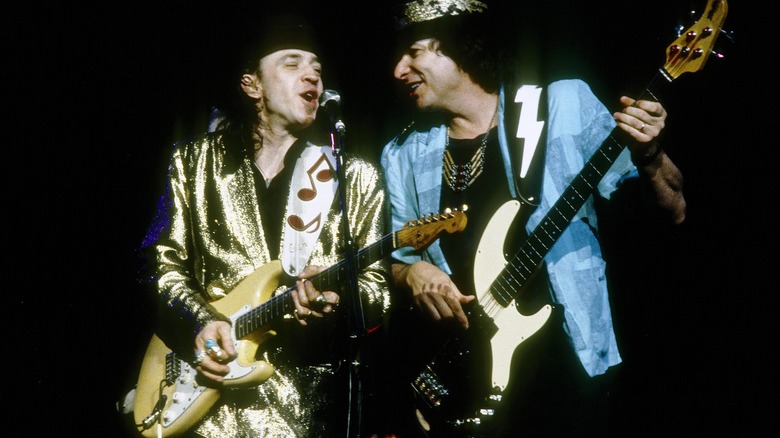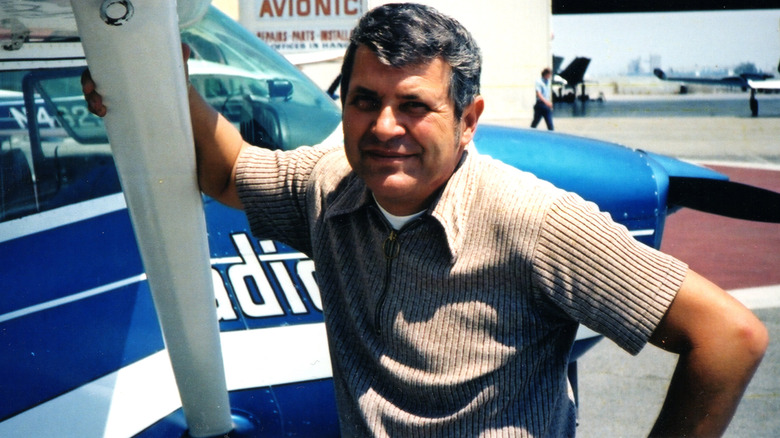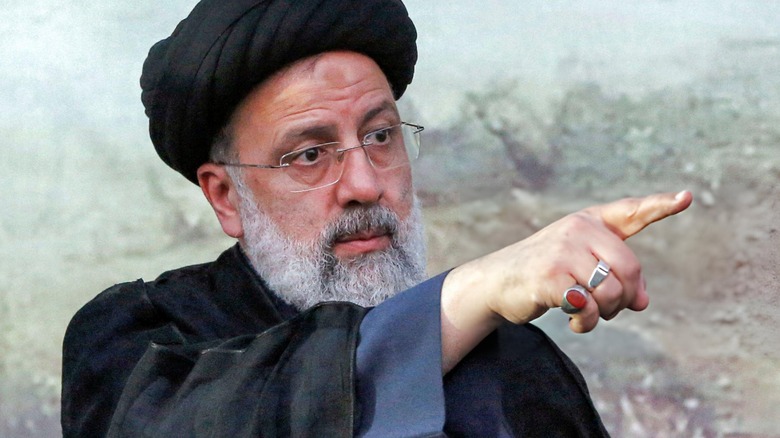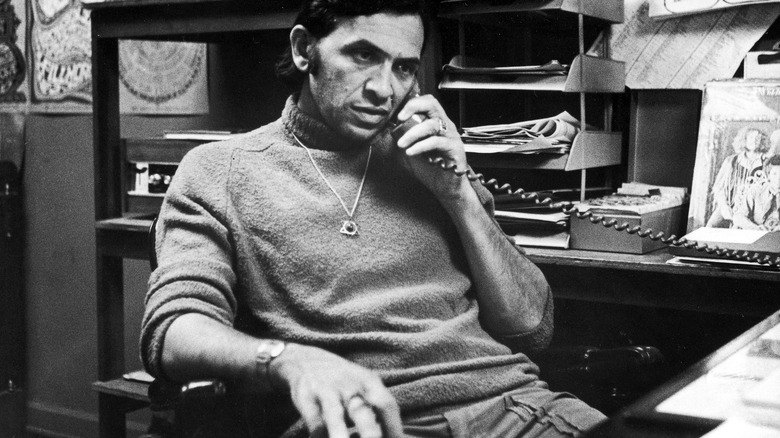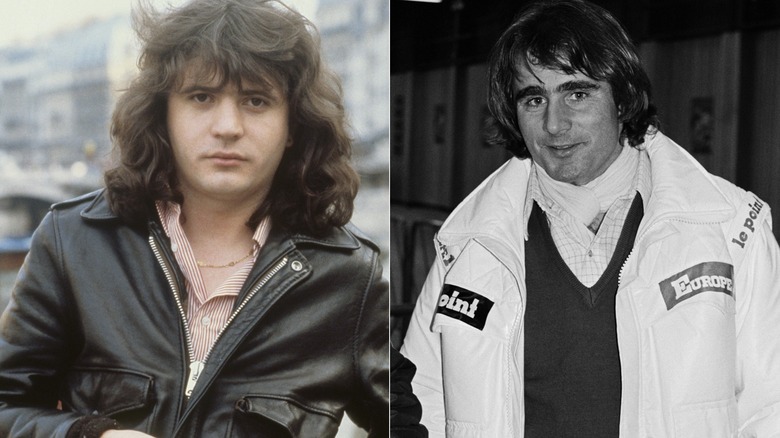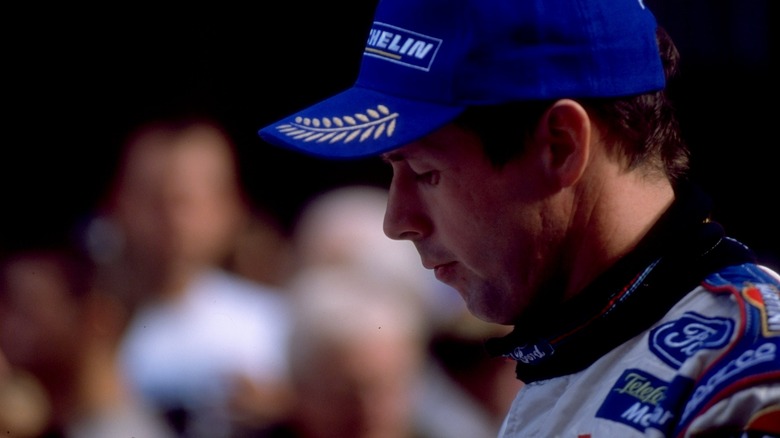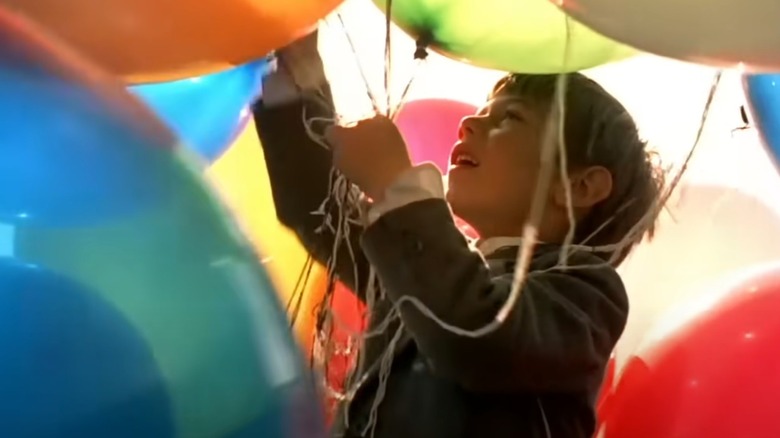Grim Helicopter Crashes That Killed Famous People
There are a lot of people who share fears of the same thing, from crowds and spiders to snakes, holes, and of course, flying. That's completely understandable: It's easy to see how it would be terrifying to sail through the air, thousands of feet above the ground, in a tin can built by the lowest bidder. It's not just ordinary people who fear flying, either, and there are a number of celebrities who have refused to take this travel short cut.
Aretha Franklin refused to fly after a terrifying incident that took place in the 1980s, and Blink-182 drummer Travis Barker understandably avoided flying after he was involved in a plane crash that claimed the lives of four people and left him suffering from severe burns. And here's a terrifying piece of information that comes thanks to the International Helicopter Safety Team: Helicopter accidents were at one point — between 1997 and 2005 — on the rise at an annual rate of about 2.5% per year. The years between 2016 and 2018 saw another spate of annual increases.
It turns out that they're one of the most dangerous forms of transportation due to a number of factors, from susceptibility to changes in weather conditions to the fact that they're actually more complex than airplanes. Over the years, they've claimed some high-profile lives, so let's look back at some of the helicopter crashes that have resulted in headline-making fatalities.
Vic Morrow
Vic Morrow was already an established actor when he appeared in "Twilight Zone: The Movie," and what should have been just one part in a pretty lackluster film ended up being one of the most notorious events in film history. Morrow and two children — Renee Chen and Myca Dinh Le — were filming a scene where they were being chased by a helicopter. The helicopter crashed, and all three were killed.
Things started to go very wrong when pyrotechnics swallowed the helicopter and forced it to the ground. The silence that followed the crash was reportedly broken by the screaming of 6-year-old Renee Chen's mother, and in hindsight, the lines that Morrow was supposed to say at the end of the scene are ironic (via Slate): "I'll keep you safe, kids. I promise. Nothing will hurt you, I swear to God."
The incident kicked off a manslaughter trial for director John Landis, and the deaths overhauled the way movies were made. Safety measures — including new standards for fixed-wing aircraft and pyrotechnics — were made mandatory, and risk assessment professionals were assigned to sets to make sure safety concerns were addressed. Landis, meanwhile, was acquitted and made a slew of other films, including "Coming to America." That production was such a miserable experience that Eddie Murphy once said (via The New York Times), "Vic Morrow has a better chance of working with Landis [again] than I do."
Stevie Ray Vaughan
When Stevie Ray Vaughan was killed in a helicopter crash on August 27, 1990, it's safe to say that the loss left a massive mark on music history. The crash — which happened when the helicopter blades clipped a ski lift cable, according to a police investigator — happened not long after the small group took off from a southern Wisconsin airfield following Vaughan's final performance: a concert at the Alpine Valley Theater.
In 2020, D ran a piece by Colin Cahoon, one of the attorneys who had investigated the crash on behalf of Allison Gas Turbine, the company that built the helicopter's engine and was sued — alongside aircraft manufacturer Bell Helicopter — by the families of the deceased. Cahoon had staged a recreation of the crash to see if he could determine what had happened. At the controls of a helicopter in similar foggy conditions, he blamed disorientation caused in large part by parking lot lights.
Double Trouble bassist Tommy Shannon (pictured with Vaughan) shared the moment he'd learned about Vaughan's death (via Louder Sound): "That's probably the worst moment of my entire life. After we got the news, a security guard let me and Chris [Layton] into Stevie's room, and when we saw that the bed hadn't been slept in, that's when it started to feel real to me. ... when we were walking in, the radio was on and that Eagles song, the one with the line, 'I may never see you again,' was playing. I always thought that was so eerie."
Kobe Bryant
It's a tragic fact that we never truly know what communications will be our last. When Kobe Bryant was killed in a 2020 helicopter crash, it was later revealed that his last text messages involved reaching out on behalf of a friend, in the hopes of helping that friend's daughter get an internship in the sports industry. (Read more about Bryant's last messages — and the final texts of other athletes — here.) It was sent just moments before the January 26, 2020, helicopter crash that claimed his life and the lives of eight others, including his 13-year-old daughter, Gianna.
Bryant flew via helicopter frequently: The vehicle that he died in was the same helicopter that had ferried him to his final game with the Lakers. The investigation into what happened produced 1,852 pages of evidence, and it wasn't until the following year that the findings were released. The official cause had been ruled to be pilot error, disorientation, and poor visibility.
Amid the outpouring of grief and tributes also came the worst in people, when first responders shared graphic photos of the crash site — including photos of Bryant and his daughter. Widow Vanessa Bryant described learning of the leak (via Sky News), saying, "I felt like I wanted to run, run down the block and scream. It was like the feeling of wanting to run down a pier and jump into the water." She sued Los Angeles County, and was awarded $28.5 million in compensation for the trauma. (Read more about the day of Kobe Bryant's death here.)
Francis Gary Powers
It was the morning of May 1, 1960, when Francis Gary Powers took off on a nail-biting recon flight, planning on taking a U-2 spy plane across the Soviet Union. After being shot down and freeing himself from the plummeting aircraft, he was captured by Soviet forces and taken to KGB headquarters in Moscow. Powers was convicted of espionage and given a 10-year jail sentence, but in 1962, he was traded for a Soviet spy.
The trade — and the fact that Powers hadn't opted to take the poison he had been given before he set out on his flight — was massively controversial. Still, he continued working with the CIA and also became a U-2 test pilot for Lockheed Martin. In 1976, he began working as a traffic reporter and pilot for Los Angeles' KNBC News Channel 4. The following year, he died in a tragic helicopter accident.
The 47-year-old Powers died on August 1, 1977, when his helicopter crashed in an accident that was later attributed to a malfunctioning fuel gauge. After reporting on Santa Barbara brush fires, he checked in and was told that he would probably be instructed to continue coverage of the fires. About 10 minutes later, he requested an emergency landing; within minutes, the helicopter crashed near an Encino baseball field, killing Powers and his cameraman. Years later, Powers' son continued to speak about his father's place in history. In 2020, Francis Gary Powers Jr. told 12 On Your Side, "He did everything he was supposed to do."
Troy Gentry
The country music duo Montgomery Gentry were looking forward to finishing up their latest album when Troy Gentry was killed in a helicopter crash. The September 8, 2017, crash happened when the pair were in New Jersey for a concert. Ahead of the show, Gentry decided to take a pleasure flight while Eddie Montgomery waited at the venue's airport. It wasn't until November of that year that Montgomery spoke with People to share just how devastating the loss of his longtime friend had been.
"A little piece of my soul got lost there," he said. "It was a horrific day; my world changed as much as the band did. It's something that you never get over. It's going to be in my mind and my soul for the rest of my life."
Gentry had initially survived the crash, which happened just minutes after the helicopter took off. He was rushed to the hospital and died there; Montgomery was with him. In 2018, the National Transportation Safety Board released their findings, blaming the crash on a combination of pilot error and improper maintenance, which led to the problems in the first place. Montgomery stated that while he would continue to play and perform, Gentry would not be replaced: "He was more than just a singer. He was a brother and he was always there. As far as I'm concerned, we're still making music together."
Davey Allison
Davey Allison was one of NASCAR's rising stars, the son of racing legend Bobby Allison. He was a mainstay in some of NASCAR's biggest races of the 1980s, went head-to-head with his father in 1987's Daytona 500, and started winning in Talladega. In 1988, he lost the Daytona 500 by two car lengths. The winner? His father. Davey kept bringing in the wins, yet his career was cut short when he was killed after the helicopter he was flying crashed in the middle of the infield at the Talladega Speedway.
It was July 13, 1993, and the following day, The Washington Post ran an interview with fellow driver Red Farmer. Farmer had been in the helicopter with Allison, and although he had been injured, he remembered the moments of the crash. "I could see the ground. I could see the sun," he said, recalling the moment Allison lost control. While Farmer was able to brace himself then kick the windshield out to be dragged to safety by a stock car driver who'd been on-scene, Davey had been knocked unconscious.
He never regained consciousness and was pronounced dead at a nearby hospital. Exactly what happened wasn't clear, and eyewitness reports didn't give any firm answers as to why the crash happened. It wasn't until 1995 that the National Transportation Safety Board released their official findings, blaming the crash on pilot error and inexperience coupled with a small landing area and dangerous winds.
Ebrahim Raisi
In 2024, the death of Iranian president Ebrahim Raisi sent shockwaves around the world as global news outlets reported that Raisi — who was elected in a 2021 vote that had been arranged to be largely uncontested — had been killed in a helicopter crash. Raisi had been traveling in a three-helicopter convoy when his aircraft went down outside of a village in East Azerbaijan, killing not only Raisi but also his foreign minister, Hossein Amir-Abdollahian.
The dignitaries had been attending the opening of a dam over the weekend, and were returning when bad weather reportedly caused the crash. Weather conditions — including heavy fog and low temperatures — also made search and rescue operations difficult, and more than 70 teams of workers were sent out to try to reach the crash site.
Iran, meanwhile, scrambled to convene emergency meetings and put protocols in place that would allow for Raisi's replacement to be elected, which — by Iranian law — needed to happen within 50 days. They also scrambled, reported CNN, to assure there "will not be the slightest disturbance" to government affairs. Raisi's death came at a time when the entire region was at a height of political and economic instability, and it was Raisi who was largely credited with spearheading the recent Iran-backed attacks on Israel. His presidency was marked by a push to manufacture weapons-grade uranium, accusations of human rights violations, and claims that he was being eyed to replace Ayatollah Khamenei.
Bill Graham
Bill Graham's story is fascinating: The German-born Graham was orphaned, escaped Paris ahead of Nazi occupation, served during the Korean War, and then went on to overhaul rock and roll. That started with his promotion of the then-unknown Jefferson Airplane, and after finding success in the psychedelic scene, he went on to establish now-familiar practices like merchandising t-shirts and promoting concerts with not just posters, but works of art. He was behind some of the biggest concerts for groups like the Rolling Stones, the Grateful Dead, and the Doors, as well as events such as Live Aid and benefit concerts for groups like Amnesty International.
His incredible life story came to an end when he was killed in a helicopter crash on October 25, 1991. Graham had been at one of the many benefit concerts he arranged — this one featuring Huey Lewis and the News, to help the victims of California wildfires — and was returning home when the helicopter he was in was blown off-course by stormy weather and collided with a high-voltage transmission tower.
It was around a day before the helicopter and the remains of the ill-fated passengers — including Graham's girlfriend, Melissa Gold — could be recovered and removed. A week and a half later, around 300,000 people gathered for a memorial concert in San Francisco, where artists including (but not limited to) Bobby McFerrin, John Fogerty, Joan Baez, the Grateful Dead, and Journey performed a tribute to the man who had shaped the industry.
Daniel Balavoine and Thierry Sabine
Every nation has their headline-making musicians, and in France, Daniel Balavoine (left) was one of the biggest stars of the 1980s. By the time he released his eighth album in 1985, he had moved on to becoming a humanitarian activist. It was partially that activism that put him on the same ill-fated helicopter as Thierry Sabine, the architect of the notorious Dakar Rally, a grueling cross-country auto race. Balavoine — who had competed in Dakar in 1983 and 1985 — had headed to Mali in a partnership with the charity Paris du Coeur.
Balavoine was on-site in collaboration with a humanitarian effort to install fresh water pumps, and joined Sabine in a helicopter search for vehicles that had been lost somewhere along the Dakar's 8,700-mile route. The 1986 rally was condemned from the start for what was said to be an unthinkably, ridiculously difficult course from start to finish, and when a number of vehicles got waylaid by high winds and sands, Sabine and Balavoine, along with two pilots and a journalist, were killed in a helicopter crash as they searched for missing vehicles.
The official cause of the accident was poor visibility due to a combination of high winds, sand, and darkness: The helicopter crashed into a 100-foot tall sand dune just outside of Timbuktu. Honda's Philippe Bourserault commented on Sabine's death, saying (via The Washington Post), "He died in the country he loved on a rally which he created. His wish was that, whatever happened to him, the race would continue."
Colin McRae
What NASCAR is to America, rally driving is to the rest of the world. Colin McRae was one of the best, securing 25 World Championship wins and becoming the first British driver to take the World Rally Championship title. He was also the youngest: At the time, he was 27 years old. Co-driver Nicky Grist told the BBC what it was like to be in McRae's custom Subaru Impreza: "That whole car was developed around Colin — it was an extension of himself and he made it dance. ... We lived the dream." That dream came to a tragic end on September 15, 2007, when McRae was killed in a helicopter crash that occurred in Lanarkshire. It also claimed the life of his 5-year-old son, Johnny, Johnny's friend Ben Porcelli (age 6), and another family friend.
The family had been on vacation at the time of the crash, which was such a catastrophic accident that initial reports clarified that it was not survivable — and said that the vehicle hadn't immediately been recognizable as a helicopter.
McRae's father issued a statement blaming the crash on mechanical problems, but in 2011, the release of official investigation findings suggested otherwise. Investigators found that there had been no reason for McRae to head into Mouse Valley, which ended up being the site of the fatal crash. Sheriff Nikola Stewart reported conclusions (via the BBC) that McRae's decision to fly into the valley "was imprudent, unreasonable, and contrary to the principles of good airmanship."
Albert Lamorisse
Albert Lamorisse was the groundbreaking French director who helmed a series of short films throughout the 1940s and 1950s. Not only did "The Red Balloon," "White Mane," and the feature "Stowaway in the Sky" charm audiences and critics alike, but Lamorisse also revolutionized cinema with the invention of the Helivison, which was essentially a stabilizing rig that allowed movie cameras to be safely and smoothly attached to helicopters. He also invented the board game "Risk."
Lamorisse's short films earned him the attention of the Shah of Iran, who commissioned him to make essentially a promo film for the country. Lamorisse — though he was haunted by a vivid dream he'd had about dying on the project — agreed, and began production on a film that would essentially tell the story of Iran from the point of view of the wind. The powers-that-be insisted on the inclusion of a few major elements — and it was while filming one of those scenes that Lamorisse was killed in a helicopter crash.
After initially refusing to film over the Karaj Dam, he finally relented. Unfortunately, his misgivings about how dangerous the area was were completely correct: The helicopter crashed into power lines, and both Lamorisse and the pilot were killed. (His son, Pascal — pictured above in "The Red Balloon" — survived.) In an eerie sort of memorial, the helicopter was left where it had been tangled in the lines. When the film was finally released in 1978 — eight years after the director's death in June 1970 — it received an Academy Award nomination for Best Documentary Feature.
